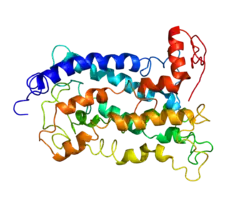P2Y12
P2Y12 is a chemoreceptor for adenosine diphosphate (ADP)[5][6] that belongs to the Gi class of a group of G protein-coupled (GPCR) purinergic receptors.[7] This P2Y receptor family has several receptor subtypes with different pharmacological selectivity, which overlaps in some cases, for various adenosine and uridine nucleotides. The P2Y12 receptor is involved in platelet aggregation and is thus a biological target for the treatment of thromboembolisms and other clotting disorders. Two transcript variants encoding the same isoform have been identified for this gene.[8]
In the field of purinergic signaling, the P2Y12 protein on the periphery is found mainly but not exclusively on the surface of blood platelets, and is an important regulator in blood clotting.[9] In the central nervous system, this receptor has been found expressed exclusively on microglia, where it is necessary for physiological and pathological microglial actions, such as monitoring neuronal functions and microglial neuroprotection.[10]
P2Y12 inhibitors
The drugs clopidogrel (Plavix), prasugrel (Efient, Effient), ticagrelor (Brilinta), and cangrelor (Kengreal) bind to this receptor and are marketed as antiplatelet agents.[5]
For acute coronary syndrome
The combination of a P2Y12 inhibitor and aspirin, called dual antiplatelet treatment, remains the first-line treatment for acute coronary syndrome. A 2019 randomized trial suggested that prasugrel is superior to ticagrelor.[11]
Antiplatelet treatment of STEMI
In patients undergoing primary PCI for an ST-segment elevation myocardial infarction (STEMI), US,[12] European,[13] and Canadian[14] guidelines recommend that a P2Y12 inhibitor should be administered as soon as possible, although it is unclear whether administration of these medications before the patient arrives at the hospital confers additional benefits compared with in-hospital administration.[14]
On the other hand, P2Y12 inhibitors do not change the risk of death when given as a pretreatment prior to routine percutaneous coronary intervention (PCI) in people who have had a non-ST-elevation myocardial infarction (NSTEMI). Though, a P2Y12 inhibitor in addition to aspirin should be administered for up to 12 months to most patients with non-ST-elevation acute coronary syndrome. They do however increase the risk of bleeding and decrease the risk of further cardiovascular problems. Thus their routine use in this context is of questionable value.[15]
A network meta-analysis of 37 studies involving 88,402 STEMI patients and 5,077 major adverse cardiac events (MACE) patients found that use of prasugrel was associated with lower mortality and MACE than other drugs in this class (clopidogrel and ticagrelor).[16]
References
- GRCh38: Ensembl release 89: ENSG00000169313 - Ensembl, May 2017
- GRCm38: Ensembl release 89: ENSMUSG00000036353 - Ensembl, May 2017
- "Human PubMed Reference:". National Center for Biotechnology Information, U.S. National Library of Medicine.
- "Mouse PubMed Reference:". National Center for Biotechnology Information, U.S. National Library of Medicine.
- Hollopeter G, Jantzen HM, Vincent D, Li G, England L, Ramakrishnan V, et al. (January 2001). "Identification of the platelet ADP receptor targeted by antithrombotic drugs". Nature. 409 (6817): 202–7. Bibcode:2001Natur.409..202H. doi:10.1038/35051599. PMID 11196645. S2CID 4423579.
- Nicholas RA (September 2001). "Identification of the P2Y(12) receptor: a novel member of the P2Y family of receptors activated by extracellular nucleotides". Molecular Pharmacology. 60 (3): 416–20. PMID 11502870.
- Murugappa S, Kunapuli SP (May 2006). "The role of ADP receptors in platelet function". Frontiers in Bioscience. 11 (1): 1977–86. doi:10.2741/1939. PMID 16368572.
- "Entrez Gene: P2RY12 purinergic receptor P2Y, G-protein coupled, 12".
- Dorsam RT, Kunapuli SP (February 2004). "Central role of the P2Y12 receptor in platelet activation". The Journal of Clinical Investigation. 113 (3): 340–5. doi:10.1172/JCI20986. PMC 324551. PMID 14755328.
- Cserép C, Pósfai B, Lénárt N, Fekete R, László ZI, Lele Z, et al. (January 2020). "Microglia monitor and protect neuronal function through specialized somatic purinergic junctions". Science. 367 (6477): 528–537. Bibcode:2020Sci...367..528C. doi:10.1126/science.aax6752. PMID 31831638. S2CID 209343260.
- Schüpke S, Neumann FJ, Menichelli M, Mayer K, Bernlochner I, Wöhrle J, et al. (October 2019). "Ticagrelor or Prasugrel in Patients with Acute Coronary Syndromes". The New England Journal of Medicine. 381 (16): 1524–1534. doi:10.1056/NEJMoa1908973. PMID 31475799.
- O'Gara PT, Kushner FG, Ascheim DD, Casey DE, Chung MK, de Lemos JA, et al. (American College of Cardiology Foundation/American Heart Association Task Force on Practice Guidelines) (January 2013). "2013 ACCF/AHA guideline for the management of ST-elevation myocardial infarction: a report of the American College of Cardiology Foundation/American Heart Association Task Force on Practice Guidelines". Circulation. 127 (4): e362-425. doi:10.1161/CIR.0b013e3182742cf6. PMID 23247304.
- Ibanez B, James S, Agewall S, Antunes MJ, Bucciarelli-Ducci C, Bueno H, et al. (ESC Scientific Document Group) (January 2018). "2017 ESC Guidelines for the management of acute myocardial infarction in patients presenting with ST-segment elevation: The Task Force for the management of acute myocardial infarction in patients presenting with ST-segment elevation of the European Society of Cardiology (ESC)". European Heart Journal. 39 (2): 119–177. doi:10.1093/eurheartj/ehx393. PMID 28886621.
- Wong GC, Welsford M, Ainsworth C, Abuzeid W, Fordyce CB, Greene J, et al. (members of the Secondary Panel) (February 2019). "2019 Canadian Cardiovascular Society/Canadian Association of Interventional Cardiology Guidelines on the Acute Management of ST-Elevation Myocardial Infarction: Focused Update on Regionalization and Reperfusion". The Canadian Journal of Cardiology. 35 (2): 107–132. doi:10.1016/j.cjca.2018.11.031. PMID 30760415.
- Bellemain-Appaix A, Kerneis M, O'Connor SA, Silvain J, Cucherat M, Beygui F, et al. (October 2014). "Reappraisal of thienopyridine pretreatment in patients with non-ST elevation acute coronary syndrome: a systematic review and meta-analysis". BMJ. 349 (aug 06 2): g6269. doi:10.1136/bmj.g6269. PMC 4208629. PMID 25954988.
- Rafique AM, Nayyar P, Wang TY, Mehran R, Baber U, Berger PB, et al. (May 2016). "Optimal P2Y12 Inhibitor in Patients With ST-Segment Elevation Myocardial Infarction Undergoing Primary Percutaneous Coronary Intervention: A Network Meta-Analysis". JACC. Cardiovascular Interventions. 9 (10): 1036–46. doi:10.1016/j.jcin.2016.02.013. PMID 27198684.
External links
- "P2Y Receptors: P2Y12". IUPHAR Database of Receptors and Ion Channels. International Union of Basic and Clinical Pharmacology.
- purinoceptor+P2Y12 at the US National Library of Medicine Medical Subject Headings (MeSH)
- Overview of all the structural information available in the PDB for UniProt: Q9H244 (Human P2Y purinoceptor 12) at the PDBe-KB.
This article incorporates text from the United States National Library of Medicine, which is in the public domain.




